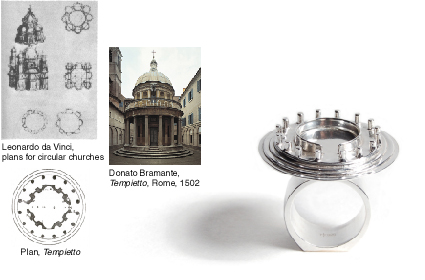|
|

Tempietto ring. In his De re aedificatoria
of c.1450, Leon Battista Alberti, architect and
first theoretician of the Italian Renaissance, defined that the
ideal shape of temples
(churches) should consist of primary forms, primarily the circle
(and its geometrical
derivatives), and seconded by the square and its geometrical derivatives.
Alberti
continued that an ideal temple should also be raised on a platform,
free on all sides,
and placed in a beautiful square.
Donato Bramante's Tempietto in Rome, built in 1502, exemplifies
these ideals. A tiny
martyrium, it can contain only 15 people. Comprised entirely of
circular forms, the steps
lead to a peristyle of 16 Doric columns, encircling a single sacred
space. Bramante also
made plans for the Tempietto to be encased in a square,
but they were never executed.
Rooted in Neo-Platonic philosophy, sacred geometry and the Greek
revival of the
mathematical interpretation of God and the world, for the Renaissance
architects, the
perfect organic form of the circle embodied celestial harmony.
Indeed, even the original
plans for the construction of the Vatican were circular in form.
While Leonardo da Vinci never actually constructed a building,
he was nonetheless
considered an architectural expert, and drew many plans for circular
constructions.
Included in the Architecture as Ornament exhibition,
June 2007.
Sterling silver. Sizes available upon request.
|